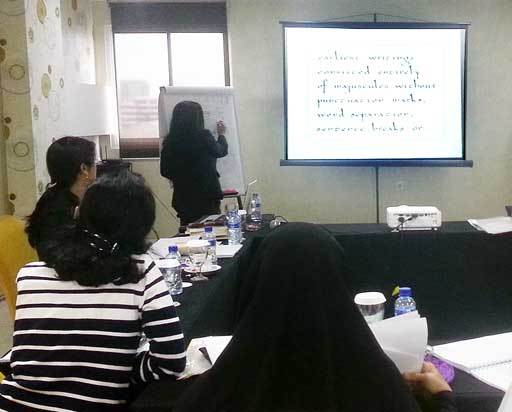In need of good luck? Change your handwriting
The way you write may just seal your fate
By Korea HeraldPublished : March 31, 2015 - 22:12
Elton John sings that it’s all written in the stars. Others beg to differ ― believing that fate, and luck, is all in handwriting.
At least, that is what graphologists, experts in the study of handwriting, believe when they analyze the shapes and patterns of handwriting to identify the writers’ characteristics.
Graphologist Vita Harsono said the logic behind the science of graphology stems from an argument that people’s handwriting is influenced by the human subconscious, which somehow correlates with their traits and characteristics.
At least, that is what graphologists, experts in the study of handwriting, believe when they analyze the shapes and patterns of handwriting to identify the writers’ characteristics.
Graphologist Vita Harsono said the logic behind the science of graphology stems from an argument that people’s handwriting is influenced by the human subconscious, which somehow correlates with their traits and characteristics.

Keeping that in mind, she could read that, for instance, people who write a perfectly round “o” are honest people, while those who write “i” with the dot perfectly aligned have good work ethics and people who write “t” with the bar high at the top of the letter have high aspirations.
“Change your handwriting, change your life,” she said on the sidelines of her graphology class in a South Jakarta hotel’s conference room.
Businesswoman Muiing found the concept acceptable, believing that graphology may have saved her marriage if she had learned about it sooner.
“I was fooled by my friend; she ran away with my husband. I could have noticed it before if I knew her handwriting,” said the 38-year-old, one of the class’ seven participants.
The mother of three said her friend’s writing was what is described in graphology as “felon’s claw,” which hints at disloyalty and dishonesty.
During the class, interactions between Vita and her students were engaging and alive, with everyone sharing their own experiences. Each class costs between 2 million rupiah ($154) and 3 million rupiah, for which trainees obtain a certificate.
Vita shared not only how to read people’s characteristics through handwriting, but also how to use graphology to improve people’s career, business and even love lives.
She once had a client who had been jobless for two years and she believed it was because of his signature, which was illegible, formed out of shell-like shapes that signified his closed-minded personality.
During a three-month consultation, she asked the client to change his signature.
“Good signatures are those which start with a capital letter, slant to the right, with the end going up,” Vita said.
In the fourth month, the client got the job he had been dreaming of.
Apart from playing a role in one’s fate, Vita said graphology could also be used as an early detection measure before choosing a business or even love partner.
“From their handwriting, you will know whether they can be trusted or not,” Vita said.
The former human resources employee said graphology was also adopted in employee recruitment systems in some companies.
“Using graphology makes the recruitment time cost efficient since you don’t need weeks to learn candidates’ personality. All you need is to see their handwriting,” said Vita, who was asked to help a bank with employee recruitment.
With the benefits of mastering graphology, many have shown an interest in knowing and learning more, like Bayu Fitri Hutami, a statistics lecturer at a private university in Jakarta.
Bayu said she was interested in graphology since it could improve her teaching methodology. She also believed it may enable her to identify a pervert in her class.
“I want to know how I can motivate my students; maybe by knowing them through their handwriting, I can know the perfect way to motivate them,” said the 37-year-old.
Despite its popularity and the public’s excitement over graphology, controversy surrounding the practice is still rife.
Psychology, for example, has never considered graphology a science because there is no scientific evidence supporting the practice.
Psychologist Anna Surti Ariani argued that graphology still plays a complementary role in psychology. “You can’t rely on handwriting analysis alone to read people’s personality; you also need other tests,” she said.
Vita, however, begs to differ. She asserts that graphology is an old and proven science dating back to the 17th century.
“So many experts have studied this and it is all supported by research and scientific experiments,” she said.
Despite the claims, it seems it will go back to people’s personal experiences with handwriting. But for Bayu, Muiing and other graphology enthusiasts, fate, and luck, is up to their handwriting.
By Ika Krismantari
(The Jakarta Post)
-
Articles by Korea Herald






![[From the Scene] Monks, Buddhists hail return of remains of Buddhas](http://res.heraldm.com/phpwas/restmb_idxmake.php?idx=644&simg=/content/image/2024/04/19/20240419050617_0.jpg&u=20240419175937)








![[From the Scene] Monks, Buddhists hail return of remains of Buddhas](http://res.heraldm.com/phpwas/restmb_idxmake.php?idx=652&simg=/content/image/2024/04/19/20240419050617_0.jpg&u=20240419175937)

![[KH Explains] Hyundai's full hybrid edge to pay off amid slow transition to pure EVs](http://res.heraldm.com/phpwas/restmb_idxmake.php?idx=652&simg=/content/image/2024/04/18/20240418050645_0.jpg&u=20240419100350)

![[Today’s K-pop] Illit drops debut single remix](http://res.heraldm.com/phpwas/restmb_idxmake.php?idx=642&simg=/content/image/2024/04/19/20240419050612_0.jpg&u=)